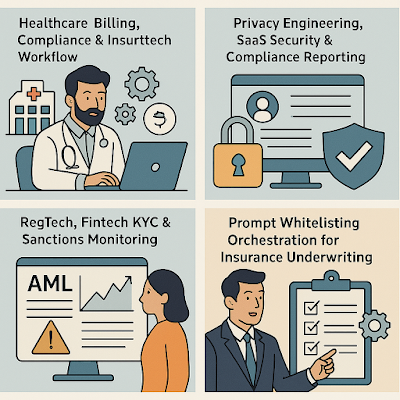Prompt Whitelisting Orchestration for Insurance Underwriting Tools
Prompt Whitelisting Orchestration for Insurance Underwriting Tools
I still remember the day an underwriter friend of mine called me up in frustration.
He was trying to push through a quote for a rare disease coverage, but the internal AI assistant kept flagging inconsistencies in lab data — inconsistencies that weren’t actually there.
“It’s like arguing with a ghost,” he said.
That moment stuck with me. Because it wasn’t the AI’s fault. It was the prompt behind it.
Insurance underwriting used to be a long, manual slog through static forms, legacy systems, and a sea of “maybe” decisions.
Today, it’s morphing — fast.
This post is for insurtech innovators, compliance nerds, and forward-thinking underwriters who want to understand how this new frontier — prompt whitelisting orchestration — is changing the game.
If you're like me — equal parts fascinated and cautious when it comes to AI in regulated spaces — you’ve probably wondered: how do you balance automation with the very human need for accountability?
📌 Table of Contents
- What Is Prompt Whitelisting?
- Top Insurance Use Cases in 2025
- Privacy and Consent Synchronization
- Healthcare Billing Integration
- KYC, AML, and Sanctions Screening
- Final Thoughts
🔍 What Is Prompt Whitelisting?
Prompt whitelisting is the practice of pre-approving only specific, structured prompts that AI systems—especially LLMs—are allowed to process in sensitive environments.
In underwriting, this means: only prompts that have been reviewed for bias, security, and context are permitted to touch PHI (Protected Health Information), claims data, or risk factors.
It’s not just about asking the right questions—it’s about ensuring that questions *can’t be asked* in the wrong way.
Think of it as giving your AI a carefully laminated playbook, instead of a blank page.
🎯 Top Insurance Use Cases in 2025
Let’s break down the most impactful areas where prompt orchestration is making a difference in real-world underwriting:
LLM Risk Triage: Pre-approved LLM instructions help classify applicants into risk pools based on medical history, lab results, and external data — all in milliseconds.
Agent Copilots: Licensed agents use AI copilots that only respond to safe, scoped prompts — like coverage comparison, deductible breakdowns, or quote simulations.
Claim Validation: In dental and vision plans, approved prompts assist in parsing scanned documents and CPT codes to pre-validate reimbursement logic.
In one case study, a boutique life insurer reduced manual underwriting time by 62% within three months of implementing an orchestrated prompt system.
🔐 Privacy and Consent Synchronization
Every underwriting flow that involves AI is, at its core, a data flow.
And data flow means privacy implications—especially when user identities and permissions change across platforms.
That’s where Consent Lifecycle Synchronization comes in.
Let’s say a user revokes consent to share EHR data in one connected app. Without synchronization, your underwriting tool might still feed that data to a prompt. Yikes.
With orchestration, consent revocations cascade instantly—blocking any prompt that relied on that revoked input.
Solutions like Transcend and 1Kosmos offer ready-to-integrate APIs to automate this real-time coordination.
💰 Healthcare Billing Integration
One of the most practical use cases for prompt orchestration? Taming the beast that is healthcare billing.
Especially in concierge care and digital therapeutics, where CPT codes evolve faster than printed contracts, dynamic AI prompts help estimate out-of-network costs or pre-bundle procedures based on historical adjudication data.
For instance, clinics using tools like Cedar integrate AI-driven prompt orchestration with payer contract modeling. One oncology group reported a 17% improvement in cash flow after automating out-of-pocket estimate flows using a whitelisted prompt layer.
Imagine a tool that says: “For this zip code, these 3 CPT combinations are most likely to be denied. Here’s your pre-authorization scenario.”
That’s not science fiction. That’s smart orchestration.
📈 RegTech, AML, and Sanctions Monitoring
Let’s step outside medical underwriting for a moment.
Prompt orchestration is quietly becoming critical in RegTech platforms handling KYC (Know Your Customer), AML (Anti-Money Laundering), and sanctions risk analysis.
Why? Because financial AI tools now use prompts to simulate risk exposure—e.g., “What happens if we lower the AML threshold for crypto transfers in Nigeria by 20%?”
That’s a powerful question. But it can’t be asked lightly.
Platforms like Trulioo or Chainalysis offer APIs, but their integration needs to respect jurisdictional guardrails. Orchestration ensures only vetted queries are made, based on locale, volume, and compliance scope.
🤝 Final Thoughts: Orchestrating for Trust
Look, I don’t pretend to have all the answers.
But I do know this: the future of underwriting will belong to those who can walk that razor-thin line between innovation and integrity — and maybe even make it look easy.
Prompt whitelisting orchestration isn't a buzzword. It’s the invisible scaffolding that lets humans trust AI in high-stakes environments.
And in a world where one misfired AI suggestion can trigger legal or ethical fallout, that scaffolding matters more than ever.
Keywords: prompt whitelisting, insurance AI governance, CPT billing automation, RegTech orchestration, consent lifecycle
